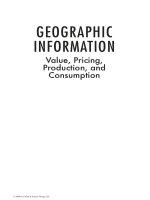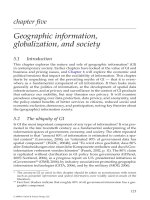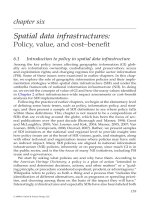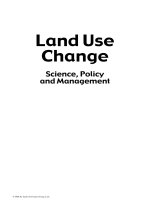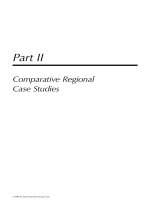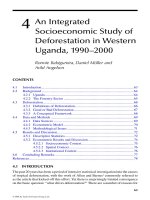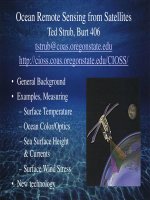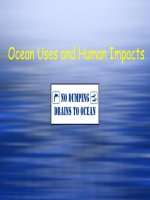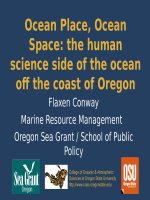Geography and Oceanography - Chapter 26 pot
Bạn đang xem bản rút gọn của tài liệu. Xem và tải ngay bản đầy đủ của tài liệu tại đây (6.41 MB, 43 trang )
Ocean Uses and Human Impacts
Outline
•
Marine Resources
•
Mariculture
•
Drugs
•
Marine pollution
•
Invasive species
•
Climate Change
Classes of Marine Resources
Physical resources
Mineral deposits, petroleum, natural gas, freshwater
Biological resources
Plants and animals, microbes
Marine energy resources
Energy from heat or motion of water
Non-extractive resources
Transportation, recreation, waste disposal
Petroleum and Natural Gas
Oil and gas are often found together beneath impermeable
caprock. Drilling for oil offshore requires specialized
equipment and is more costly than drilling on land.
Gulf of Mexico Oil Spill
5000 barrels/day 15000 barrels/day
Containment (booms), skimming,
dispersants, Domes, caps, siphons, new well
Full recovery will take many years
Salts and Minerals
•
Magnesium
•
Sodium chloride
•
Manganese nodules
•
Phosphorite
•
Metallic sulfides and muds
Fresh Water
•
Only 0.071% of Earth’s
water is liquid, fresh,
and available at the
surface for humans
•
More than 1500
desalination plants
worldwide
•
3.5 billion gallons/day,
and rising!
Marine Energy – Wave Motion
Energy generated by waves (Dr Brekken) and tides
Biological Resources
Major types of commercially harvested fishes,
crustaceans, and mollusks
Biological Resources
World Commercial Catch of Marine
Fishes, Crustaceans, and Mollusks, by
Species Group, 1997
Species Group
Millions of
Metric
Tons
Herring, sardines,
anchovies
21.5
Jacks, mullets, sauries 10.9
Mollusks 15.5
Cods, hakes, haddocks 10.2
Redfish, basses, conger
eels
7.4
Crustaceans 6.8
Tunas, bonitos, billfishes 4.8
Mackerel, snooks, cutlass
fishes
5.2
Flounders, halibuts, soles 1.0
Miscellaneous Marine
Fishes
17.5
Total for all sources 100.8
Table from Garrison, 4ed
Fisheries
Typical evolution
Typical evolution
of ocean fisheries
of ocean fisheries
Fisheries Exploitation
Concept of a Stock
A population of a species of fish that is
reproductively isolated in space and
time
Each stock must be treated separately in
assessing fishing impacts
Stock Equilibrium
Stock Size
(Exploitable
Biomass)
Growth
Recruitment
Mortality
Fishing
Removals
These four factors must remain in balance for
stock equilibrium to be achieved
Maximum Sustainable Yield
CPUE
Catch
Per
Unit
Effort
Community Effects
Altered trophic webs
Keystone species may
be removed or
reduced
Fishing down food webs
The mean trophic level
of a marine
ecosystem is reduced
So, what can YOU do?
Support sustainable fisheries with your $$
See: MBARI Seafood Watch wallet card
/>
See also:
/>
/>Potential
Harmful
Impacts of
Mariculture
Escape of non-
native species
Herbicides
Disease
tolerance and
spread
Nutrient
enrichment ->
eutrophication
Drugs
•
Researchers estimate that 10% of
marine species may contain useful
medical compounds
•
Acyclovir, the first antiviral
compound approved for humans, is
derived from a Caribbean Sea sponge
•
Pseudopterosins, a class of anti-
inflammatory drugs, is derived from
marine species
•
Bone substitute for speeding
regrowth of bone grafts is available
from Corals. Coral skeletal structure
is remarkably similar to human bone
Marine Pollution - DDT
Levels of organic
pollutants may be
low, but biological
amplification
concentrates harmful
toxins
The concentration of
DDT in the fatty
tissues of organisms
was amplified up to
10 million times in a
food chain off the
coast of New Jersey
Marine Pollution – HABs and
Anoxia
Invasive Species
Introduced species crowd out
native species, alter habitats,
and impose economic burdens
on coastal communities.
The rate of marine introductions
has risen exponentially over the
past 200 years and shows no
sign of leveling off.
More than 175 species of
introduced marine invertebrates,
fish, algae, and higher plants live
in San Francisco Bay.
/>Invasive Species – Zebra Mussel
Recent US Bioinvasions
/> />
